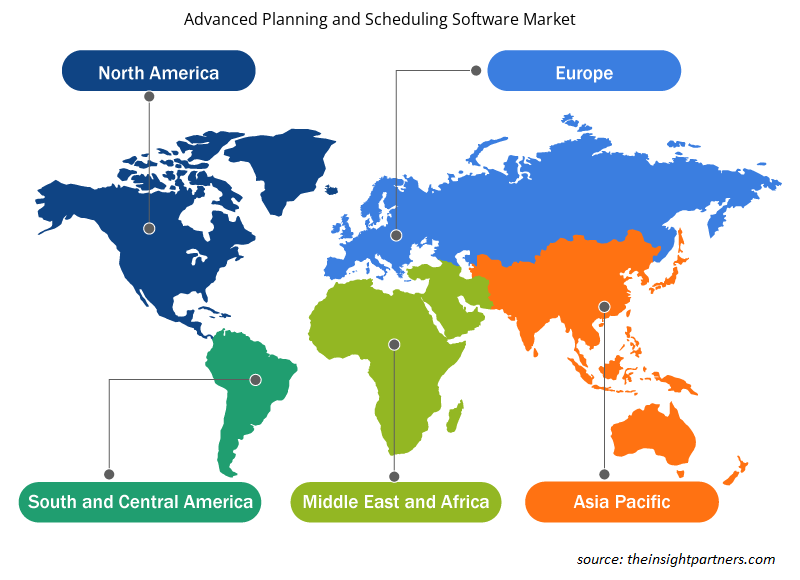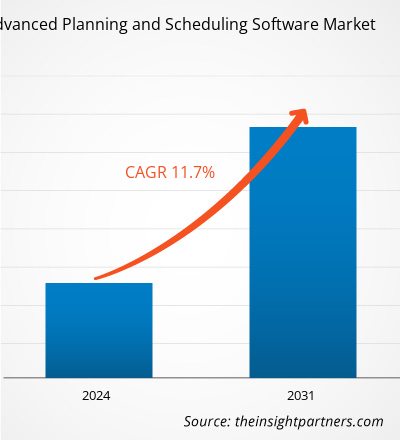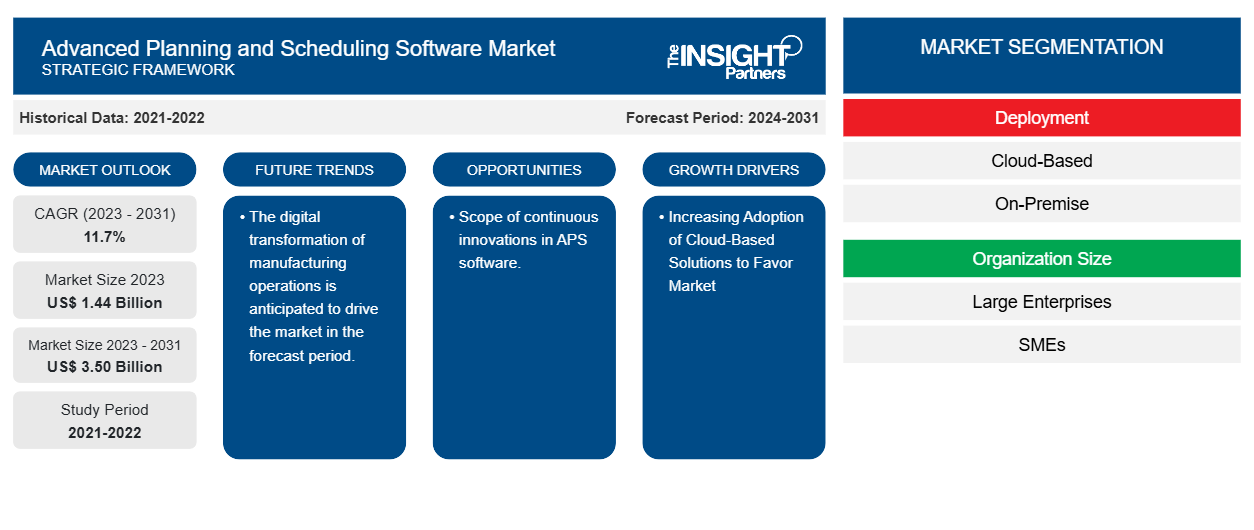高级规划和调度软件市场规模预计将从 2023 年的 14.4 亿美元增至 2031 年的 35 亿美元。预计 2023-2031 年期间,该市场的复合年增长率将达到 11.7%。对整体生产流程的不断增强的需求以及对基于云的解决方案的不断采用可能仍将是市场的主要趋势和驱动因素。
高级计划和调度软件市场分析
全球范围内,高级规划和调度软件市场正在经历显著增长。这种增长归因于对增强整体生产流程的需求不断增长以及基于云的解决方案的采用不断增加。此外,APS 软件不断创新的空间不断扩大以及制造业务的数字化转型预计将在未来几年为市场带来诸多机遇。
高级计划和调度软件市场概况
高级规划和调度 (APS) 是一种帮助制造商控制生产规划和车间调度的解决方案。高级规划和调度软件利用高级算法来平衡需求和产能并制定可实现的生产计划,从而缩短交货时间以满足客户需求,并更轻松、更快速地应对意外的生产变化。
定制此报告以满足您的需求
您可以免费定制任何报告,包括本报告的部分内容、国家级分析、Excel 数据包,以及为初创企业和大学提供优惠和折扣
-
获取此报告的关键市场趋势。这个免费样品将包括数据分析,从市场趋势到估计和预测。
高级规划和调度软件市场驱动因素和机遇
越来越多地采用基于云的解决方案来赢得市场青睐。
越来越多地采用基于云的解决方案确实推动了高级规划和调度软件市场的增长。基于云的高级规划和调度 (CAPS) 系统基于智能动态规划和调度 (IDPS),它由五个主要模块组成,包括输入、模拟、容量规划 (CP)、容量影响分析 (CIA) 和输出。此外,与本地解决方案相比,基于云的 APS 解决方案的直接投资较低。这增加了对高级规划和调度软件组织(包括中小企业)的需求。因此,考虑到上述参数,越来越多地采用基于云的解决方案正在推动高级规划和调度软件市场的增长。
APS 软件持续创新的范围。
APS 软件的持续创新范围为市场带来了重大机遇。持续创新可以实现自适应算法与ERP、MES 和 IoT 设备等系统的功能集成。它还通过变得更加用户友好、降低学习曲线和提高非技术用户的采用率来改善用户体验直观界面。APS 软件还具有定制和灵活性、预测分析、机器学习、基于云的解决方案移动访问等优势。因此,考虑到上述因素,APS 软件的持续创新范围预计将推动高级规划和调度软件市场的发展。
高级计划和调度软件市场报告细分分析
有助于得出高级计划和调度软件市场分析的关键部分是部署、组织规模和行业。
- 根据部署情况,高级规划和调度软件市场分为基于云和本地部署。预计电源管理组件部分将在预测期内占据相当大的市场份额。
- 根据组织规模,高级计划和调度软件市场分为大型企业和中小型企业。大型企业预计在预测期内将占据相当大的市场份额。
- 根据行业,市场分为制造业、制药和生命科学、零售和消费品、食品和饮料、化学品、汽车、航空航天和国防、电子等。制造业预计将在预测期内占据相当大的市场份额。
高级计划和调度软件市场份额按地区分析
高级计划和调度软件市场报告的地理范围主要分为五个区域:北美、亚太、欧洲、中东和非洲、南美和中美。
北美主导着高级计划和调度软件市场。北美市场分为美国、加拿大和墨西哥。北美地区各行业的高科技采用趋势推动了高级计划和调度软件市场的增长。数字工具的实施增加和政府机构的高技术支出等因素预计将推动北美高级计划和调度软件市场的增长。此外,美国和加拿大发达经济体高度重视研发,这迫使北美参与者将技术先进的解决方案引入市场。此外,美国拥有大量高级计划和调度软件市场参与者,他们一直在逐步专注于开发创新解决方案。所有这些因素都促进了该地区高级计划和调度软件市场的增长。
高级规划和调度软件市场区域洞察
Insight Partners 的分析师已详尽解释了预测期内影响高级规划和调度软件市场的区域趋势和因素。本节还讨论了北美、欧洲、亚太地区、中东和非洲以及南美和中美洲的高级规划和调度软件市场细分和地理位置。

- 获取高级计划和调度软件市场的区域特定数据
高级计划和调度软件市场报告范围
| 报告属性 | 细节 |
|---|---|
| 2023 年的市场规模 | 14.4亿美元 |
| 2031 年市场规模 | 35亿美元 |
| 全球复合年增长率(2023 - 2031) | 11.7% |
| 史料 | 2021-2022 |
| 预测期 | 2024-2031 |
| 涵盖的领域 |
按部署
|
| 覆盖地区和国家 |
北美
|
| 市场领导者和主要公司简介 |
|
高级规划和调度软件市场参与者密度:了解其对业务动态的影响
高级规划和调度软件市场正在快速增长,这得益于最终用户需求的不断增长,而这些需求又源于消费者偏好的不断变化、技术进步以及对产品优势的认识不断提高等因素。随着需求的增加,企业正在扩大其产品范围,进行创新以满足消费者需求,并利用新兴趋势,从而进一步推动市场增长。
市场参与者密度是指在特定市场或行业内运营的企业或公司的分布情况。它表明在给定市场空间中,相对于其规模或总市场价值,有多少竞争对手(市场参与者)存在。
在高级计划和调度软件市场运营的主要公司有:
- ACUMATICA 公司
- ASPROVA 公司
- 赛博泰克
- 达索系统公司
- 德尔福公司
- 全球店铺解决方案
免责声明:上面列出的公司没有按照任何特定顺序排列。

- 获取高级规划和调度软件市场顶级关键参与者概述
高级计划和调度软件市场新闻和最新发展
高级规划和调度软件市场通过收集一手和二手研究后的定性和定量数据进行评估,其中包括重要的公司出版物、协会数据和数据库。以下列出了高级规划和调度软件市场的一些发展情况:
- Cosmo Tech 推出了一个专用于高级规划和调度软件的 APS 连接器库。Cosmo Tech APS 连接器库提供了多个预构建的连接器,并能够与 SAP IBP、Blue Yonder、Kinaxis 和 OMP 等流行的供应链规划解决方案集成。(来源:Cosmo Tech 公司网站,2024 年 6 月)
- 总部位于宾夕法尼亚州华盛顿堡的 Amtech Software 宣布推出高级规划委员会 (APB),这是无缝集成到 Encore ERP 的最新创新。APB 是一种基于 Web 的解决方案,它使用灵活的点算法来自动化调度功能,使工厂调度员能够轻松处理多道和多部件项目。(来源:Amtech Software,公司网站,2024 年 4 月)
高级规划和调度软件市场报告覆盖范围和交付成果
“高级计划和调度软件市场规模和预测(2021-2031)”报告对市场进行了详细分析,涵盖以下领域:
- 范围内涵盖的所有关键细分市场的全球、区域和国家层面的高级规划和调度软件市场规模和预测。
- 高级计划和调度软件市场趋势以及驱动因素、限制因素和关键机遇等市场动态。
- 详细的 PEST/波特五力分析和 SWOT 分析。
- 先进的计划和调度软件市场分析涵盖关键市场趋势、全球和区域框架、主要参与者、法规和最新的市场发展。
- 行业格局和竞争分析涵盖市场集中度、热图分析、知名参与者以及先进规划和调度软件市场的最新发展。
- 详细的公司简介。
- 历史分析(2 年)、基准年、预测(7 年)及复合年增长率
- PEST和SWOT分析
- 市场规模、价值/数量 - 全球、区域、国家
- 行业和竞争格局
- Excel 数据集
近期报告
相关报告
客户评价
购买理由
- 明智的决策
- 了解市场动态
- 竞争分析
- 客户洞察
- 市场预测
- 风险规避
- 战略规划
- 投资论证
- 识别新兴市场
- 优化营销策略
- 提升运营效率
- 顺应监管趋势























 获取免费样品 - 高级计划和调度软件市场
获取免费样品 - 高级计划和调度软件市场